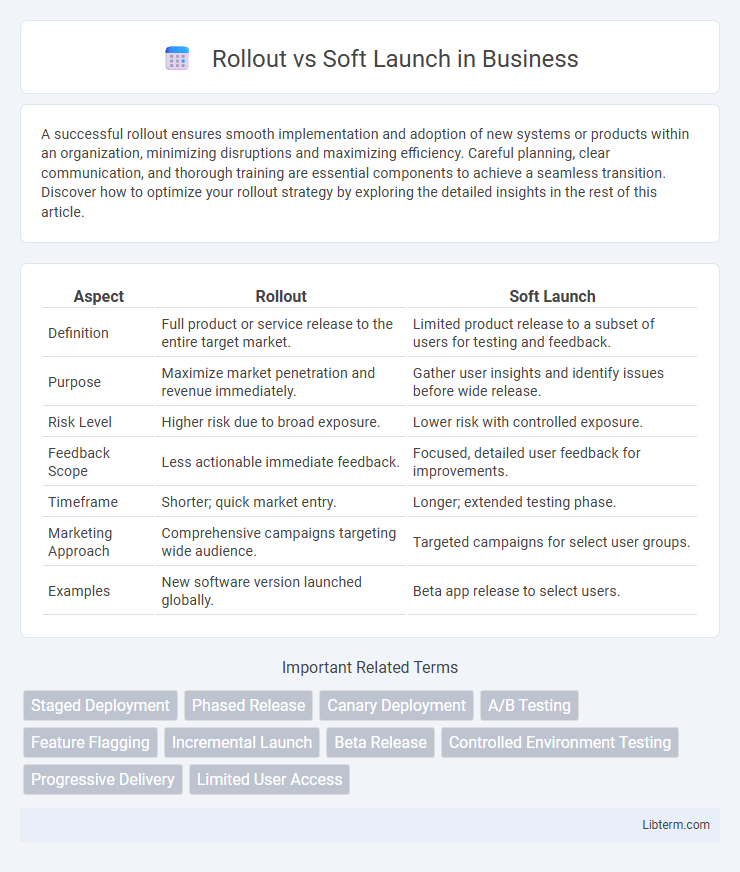A successful rollout ensures smooth implementation and adoption of new systems or products within an organization, minimizing disruptions and maximizing efficiency. Careful planning, clear communication, and thorough training are essential components to achieve a seamless transition. Discover how to optimize your rollout strategy by exploring the detailed insights in the rest of this article.
Table of Comparison
| Aspect | Rollout | Soft Launch |
|---|---|---|
| Definition | Full product or service release to the entire target market. | Limited product release to a subset of users for testing and feedback. |
| Purpose | Maximize market penetration and revenue immediately. | Gather user insights and identify issues before wide release. |
| Risk Level | Higher risk due to broad exposure. | Lower risk with controlled exposure. |
| Feedback Scope | Less actionable immediate feedback. | Focused, detailed user feedback for improvements. |
| Timeframe | Shorter; quick market entry. | Longer; extended testing phase. |
| Marketing Approach | Comprehensive campaigns targeting wide audience. | Targeted campaigns for select user groups. |
| Examples | New software version launched globally. | Beta app release to select users. |
Understanding Rollout and Soft Launch: Key Differences
Rollout refers to the gradual release of a product or feature to a wider audience, enabling real-time monitoring and iterative improvements based on user feedback. Soft launch involves releasing a product in a limited market or audience segment to test performance and gather data before a full-scale launch. The key difference lies in scope and intent: rollout targets incremental expansion after initial validation, while soft launch focuses on early-stage testing in controlled environments.
When to Choose a Rollout vs Soft Launch
Choose a rollout when targeting a broad user base with a fully developed product ready for immediate scaling and extensive feedback collection. Opt for a soft launch to test specific features, gather initial user insights, and identify potential issues within a smaller, controlled audience before a full release. Decision factors include product maturity, risk tolerance, and the need for iterative improvements based on real user data.
Benefits of a Full Rollout Strategy
A full rollout strategy enables immediate access to the complete product for all users, maximizing market penetration and accelerating feedback collection from a diverse audience. This approach enhances brand visibility and creates stronger initial momentum, driving higher adoption rates and faster revenue growth. Comprehensive data gathered during a full rollout supports robust performance analysis and swift iteration on product features.
Advantages of a Soft Launch Approach
A soft launch allows businesses to test their product or service with a limited audience, gathering critical user feedback to refine features and fix bugs before full-scale release. This approach minimizes risk by identifying potential issues in real-world scenarios, improving overall user satisfaction and reducing costly post-launch fixes. Early user engagement during a soft launch also aids in building anticipation and word-of-mouth promotion ahead of the wider rollout.
Step-by-Step Guide to Planning a Rollout
Planning a rollout involves defining clear objectives, identifying target audiences, and setting measurable success criteria to ensure a smooth product introduction. Develop a detailed timeline that includes development milestones, internal testing phases, and staggered user engagement to monitor performance and gather feedback effectively. Coordinate cross-functional teams for communication, training, and support while preparing contingency plans to address potential issues during the rollout process.
Best Practices for Conducting a Soft Launch
Conducting a soft launch involves releasing a product to a limited audience to gather valuable user feedback and identify potential issues before a full rollout. Best practices include selecting a representative sample of target users, setting clear objectives for performance metrics, and closely monitoring user behavior to make iterative improvements. This approach minimizes risks and enhances product readiness by leveraging real-world data in a controlled environment.
Common Challenges in Rollouts and How to Overcome Them
Rollouts often face challenges such as user resistance, technical glitches, and inadequate training, which can impede smooth implementation. Overcoming these issues requires thorough user engagement strategies, robust testing phases, and comprehensive training programs to ensure readiness. Leveraging feedback loops and iterative updates helps address user concerns and technical problems promptly, enhancing overall adoption and performance.
Measuring Success: Rollout vs Soft Launch Metrics
Measuring success during a rollout involves tracking broad adoption metrics such as user engagement, system stability, and performance across diverse market segments. Soft launches focus on targeted metrics like initial user feedback, bug reports, and conversion rates within a controlled audience to identify potential issues early. Comparing these metrics helps optimize product performance by balancing wide-scale impact assessment with detailed user experience insights.
Real-World Examples of Rollouts and Soft Launches
Rollouts often involve large-scale releases like Microsoft Windows updates, where new features are gradually enabled across millions of users to minimize disruption and gather performance data. Soft launches are common in mobile gaming, exemplified by companies like Supercell, which release games in select regions such as Canada or Australia to test user engagement and refine gameplay before a global debut. These strategies enable data-driven improvements and risk mitigation tailored to product type and market dynamics.
Choosing the Right Launch Method for Your Product
Choosing the right launch method depends on your product's complexity, target audience, and market readiness. A soft launch allows for limited release to gather user feedback and identify issues before a full rollout, minimizing risks and refining the product experience. In contrast, a rollout involves a broader, phased introduction to maximize market impact and scale quickly, ideal for well-tested products with strong demand forecasts.
Rollout Infographic

 libterm.com
libterm.com